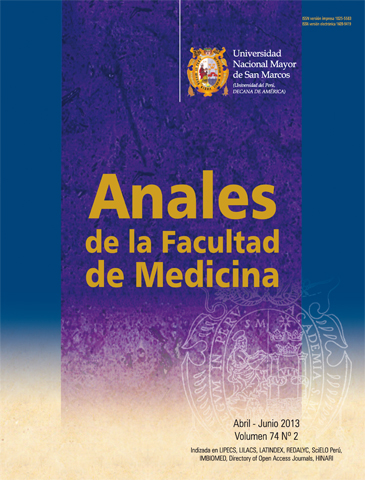COMT gene polymorphism in a sample of pregnant women with intruterine growth restriction in a Lima hospital
DOI:
https://doi.org/10.15381/anales.v74i2.2385Keywords:
Intrauterine growth restriction, pathophysiology, cathecol-O-methyltransferase, cathecol estrogens, COMT gene Val158Met polymorphism.Abstract
Background: Cellular and molecular events in the pathophysiology of intrauterine growth restriction (IUGR) are still unknown. Cathecol-O-methyltransferase (COMT) is a phase II enzyme that inactivates cathecol estrogens by transferring a methyl group. A functional polymorphism Val158 Met in COMT gene is known as susceptible marker for diverse maternal and perinatal diseases, and studies suggest the allele codifying a low activity COMT may be a susceptible marker for IUGR. COMT polymorphism study may be a new strategy to determine genetic markers that might be used for detection of certain disorders related to pregnancy. Objectives: To determine association of Val158Met cathecol-O-methyltransferase (COMT) polymorphism and intrauterine growth restriction. Setting: Faculty of Medicine, Universidad Nacional Mayor de San Marcos, Lima, Peru. Design: Relational (associative), observational, casecontrol (non-experimental) study. Materials: Maternal blood samples obtained following delivery. Methods: During 2011, 81 blood samples were obtained from post partum mothers for COMT gene genotyping, 26 (32.1%) were mothers with IUGR (cases) and 55 (67.9%) without IUGR (controls). Genotype distribution was determined by chi square test. Genotypes proportional distribution in IUGR and non-IUGR groups was determined with Hardy-Weinberg’s null hypothesis. All women signed informed consent. Main outcome measures: Association of COMT genotypes and IUGR, and between COMT Val/Met alleles and IUGR. Results: Genotype distribution in IUGR and non-IUGR groups agreed with Hardy-Weinberg null hypothesis. There was no association of COMT Val/Met genotypes and IUGR, X2=1.8057, gl=2, p=0.4054. There was no association between COMT Val/Met alleles and IUGR, X2=0.3659, gl=1, p=0.5453. Conclusions: No association was found either between COMT genotypes and IUGR or between COMT Val/Met alleles and IUGR.Downloads
Published
2013-06-10
Issue
Section
Original Breve
License
Copyright (c) 2013 José Pacheco-Romero, Doris Huerta, Oscar Acosta, Santiago Cabrera

This work is licensed under a Creative Commons Attribution-NonCommercial-ShareAlike 4.0 International License.
Those authors who have publications with this magazine accept the following terms:
- Authors will retain their copyrights and guarantee the journal the right of first publication of their work, which will be simultaneously subject to Creative Commons Attribution License that allows third parties to share the work as long as its author and its first publication this magazine are indicated.
- Authors may adopt other non-exclusive licensing agreements for the distribution of the version of the published work (eg, deposit it in an institutional electronic file or publish it in a monographic volume) provided that the initial publication in this magazine is indicated.
- Authors are allowed and recommended to disseminate their work over the Internet (eg: in institutional telematic archives or on their website) before and during the submission process, which It can produce interesting exchanges and increase quotes from the published work. (See El efecto del acceso abierto ).
How to Cite
1.
Pacheco-Romero J, Huerta D, Acosta O, Cabrera S. COMT gene polymorphism in a sample of pregnant women with intruterine growth restriction in a Lima hospital. An Fac med [Internet]. 2013 Jun. 10 [cited 2025 Jun. 5];74(2):129-32. Available from: https://revistasinvestigacion.unmsm.edu.pe/index.php/anales/article/view/2385



